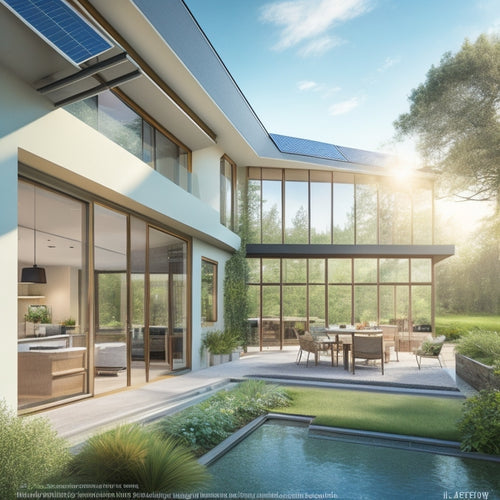
10 Sustainable Insulation Innovations for Electric Vehicle Efficiency
Share
By integrating advanced insulation technologies into your electric vehicle, you can greatly reduce heat loss, minimize weight, and maximize battery performance. For instance, aerogel insulation can reduce thermal conductivity by up to 90%, while vacuum insulation panels can achieve thermal conductivity as low as 0.004 W/mK. Eco-friendly options like bio-based insulation materials and low-carbon recycled denim insulation offer sustainable solutions. High-performance insulation solutions, such as carbon fiber and graphene-based thermal insulators, can further enhance vehicle efficiency. As you investigate these innovations, you'll uncover how they can help you optimize your EV's energy efficiency, extend driving ranges, and reduce environmental impact, with even more innovative solutions waiting to be found.
Key Takeaways
- Advanced insulation technologies like aerogel and vacuum insulation panels minimize heat transfer and reduce energy loss in electric vehicles.
- Eco-friendly insulation options, including bio-based materials and recycled denim, offer sustainable solutions with reduced environmental impact.
- High-performance insulation solutions like carbon fiber and graphene-based thermal insulators enhance vehicle efficiency and range.
- Thermal management enhancements, such as phase change material integration and high-temperature insulation coatings, optimize component operation and reduce energy waste.
- Lightweight and reflective insulation options, including carbon fiber composites and reflective insulation, improve energy efficiency and reduce vehicle weight.
Advanced Aerogel Insulation Systems
Advanced Aerogel Insulation Systems employ state-of-the-art aerogel manufacturing techniques to produce materials with unmatched thermal performance.
With thermal conductivity as low as 0.013 W/mK, aerogel insulation can minimize heat transfer by up to 90%. This means you can maintain ideal battery temperatures, ensuring increased efficiency, range, and overall performance.
As electric vehicles continue to progress, extended driving ranges and reduced charging times are becoming more prevalent, making aerogel insulation an essential component in sustainable electric vehicle design.
By integrating aerogel insulation into electric vehicle design, you'll experience enhanced thermal management, reduced energy consumption, and a significant decrease in greenhouse gas emissions.
Take advantage of aerogel's extraordinary thermal properties to unleash the full potential of sustainable electric vehicle technology.
Bio-Based Insulation Materials
As you investigate innovative insulation solutions for electric vehicles, you'll find that bio-based materials are gaining traction as a sustainable alternative to traditional insulation methods.
These eco-friendly options utilize natural fiber composites, such as hemp, flax, and jute, to create high-performance insulation systems. By employing the unique properties of these fibers, bio-based materials can achieve impressive thermal resistance while minimizing environmental impact.
Furthermore, biodegradable insulation options made from renewable resources like corn starch, potato starch, or sugarcane can reduce waste and lower carbon emissions.
In addition, the integration of renewable energy solutions can further enhance the sustainability of electric vehicles, making them a more viable option for eco-conscious consumers.
With continued research and development, bio-based insulation materials are ready to revolutionize the electric vehicle industry, providing a cleaner, greener, and more sustainable future for transportation.
Carbon Fiber Insulation Solutions
You'll find that carbon fiber insulation solutions offer significant thermal performance enhancement, with some materials boasting up to 30% better thermal insulation than traditional options.
Additionally, carbon fiber's exceptional strength-to-weight ratio enables the creation of lightweight material options, reducing the overall weight of electric vehicles and increasing their energy efficiency.
By integrating high-efficiency solar panels with anti-reflective coating solar energy solutions, you can further optimize your EV's thermal management system and improve its overall sustainability.
This approach can lead to lower operating costs and increased profit margins, as well as a reduced carbon footprint.
Thermal Performance Enhancement
Through strategic integration, carbon fiber insulation solutions can greatly enhance the thermal performance of electric vehicles, thereby reducing heat-related losses and increasing overall energy efficiency.
Additionally, solar-powered charging solutions can also reduce carbon emissions and promote energy independence, aligning with corporate sustainability initiatives.
You can refine thermal conductivity by tailoring the carbon fiber's structural properties to minimize heat transfer. This results in improved insulation performance metrics, such as reduced thermal bridging and increased R-values.
By achieving ideal thermal performance, you can extend the driving range of your electric vehicle, reduce energy consumption, and minimize environmental impact.
Moreover, carbon fiber insulation solutions can be designed to meet specific thermal requirements, ensuring that your electric vehicle operates efficiently in various climate conditions.
Lightweight Material Options
Maximizing electric vehicle design requires careful consideration of material selection to minimize weight while maintaining performance. As you investigate lightweight material options, you'll find that carbon fiber insulation solutions offer a unique combination of benefits.
By leveraging renewable energy solutions, EV manufacturers can further reduce their carbon footprint and promote sustainable practices. Additionally, adopting solar-powered EV charging stations can minimize reliance on the grid and provide a stable energy supply.
-
Reduced weight: Carbon fiber composites can reduce insulation weight by up to 50% compared to traditional materials, resulting in improved energy efficiency and increased range.
-
Sustainable sourcing: Look for suppliers that use recyclable insulation materials and sustainable sourcing practices to minimize environmental impact.
-
Natural fiber integration: Combining carbon fiber with natural fibers can enhance thermal mass and energy absorption, while also providing design flexibility.
- Performance metrics: When selecting a carbon fiber insulation solution, consider metrics such as thermal conductivity, compressive strength, and moisture absorption to guarantee peak performance.
Eco-Friendly Fiberglass Alternatives
Most electric vehicle manufacturers rely on fiberglass insulation to reduce heat transfer and energy loss. However, you're likely aware of the environmental drawbacks of traditional fiberglass.
Fortunately, eco-friendly alternatives are emerging, offering sustainable solutions for energy conservation. As the transportation sector shifts towards electrification, renewable energy sources play an essential role in reducing greenhouse gas emissions.
By adopting renewable energy, fleet owners can considerably lower their carbon footprint and operating costs. You can now opt for insulation made from recycled materials, sourced from sustainable suppliers with eco-certification.
This shift not only reduces the environmental impact of manufacturing processes but also enhances product performance. As consumer awareness grows, market trends are driving demand for eco-friendly insulation options.
Graphene-Based Thermal Insulators
What if you could employ the exceptional thermal conductivity of graphene to minimize heat transfer in electric vehicles? This innovative material has the potential to greatly reduce energy losses, increasing your vehicle's overall efficiency and range.
By incorporating graphene composites into thermal insulation systems, you can take advantage of graphene's high thermal conductivity, which is up to 5,000 W/mK.
Here are some key benefits of graphene-based thermal insulators:
-
Improved thermal performance: Graphene's high thermal conductivity enables efficient heat transfer, reducing energy losses and increasing overall system efficiency.
-
Lightweight design: Graphene-based insulators are often lighter than traditional materials, reducing vehicle weight and further improving efficiency.
-
Enhanced durability: Graphene composites exhibit excellent mechanical properties, ensuring reliable performance over the vehicle's lifespan.
- Scalable production: Graphene-based insulators can be produced using scalable methods, making them a viable solution for widespread adoption.
High-Temperature Insulation Coatings
As you investigate ways to maximize the efficiency of electric vehicles, another key area of focus is the development of high-temperature insulation coatings.
These coatings play a critical role in reducing heat transfer and energy losses in high-temperature applications, such as electric motor components and battery management systems.
By creating an effective thermal barrier, high-temperature insulation coatings can help minimize energy waste and optimize EV performance.
Researchers are now exploring advanced materials and nanotechnology-based approaches to develop coatings with improved thermal insulation properties.
With the ability to withstand temperatures above 1000°C, these coatings can greatly enhance the overall efficiency and sustainability of electric vehicles.
Innovative Vacuum Insulation Panels
You'll find that innovative vacuum insulation panels can greatly enhance thermal performance, with some designs achieving thermal conductivity as low as 0.004 W/mK.
By optimizing vacuum panel design, you can minimize heat transfer and maximize energy efficiency gains, resulting in up to 50% reduction in thermal losses.
With these advancements, you can expect substantial energy savings and extended driving ranges for electric vehicles.
Thermal Performance Boost
Vacuum insulation panels (VIPs) have emerged as a breakthrough in the quest for enhanced thermal performance in electric vehicles.
You're now enabled to optimize your EV's thermal management strategies and insulation material selection.
By incorporating VIPs, you can:
- Achieve thermal conductivity as low as 0.004 W/mK, surpassing traditional insulation materials.
- Reduce heat loss by up to 50%, resulting in increased battery life and range.
- Minimize material usage, contributing to a more sustainable and environmentally friendly design.
- Enhance overall vehicle efficiency, allowing you to go further on a single charge.
Vacuum Panel Design
To take full advantage of VIPs' exceptional thermal performance, careful consideration must be given to their design and integration into EVs. As you design innovative vacuum insulation panels, you'll face unique challenges. One major hurdle is ensuring the vacuum panel's structural integrity while minimizing its weight. Another challenge is selecting materials that can withstand the evacuated environment.
| Design Aspect | Challenge | Solution |
|---|---|---|
| Structural Integrity | Maintaining panel shape under vacuum | Use of high-strength, lightweight materials |
| Material Selection | Ensuring material compatibility with vacuum | Material testing and selection for vacuum stability |
| Panel Thickness | Balancing thermal performance with weight | Optimizing panel thickness for thermal insulation |
| Edge Sealing | Preventing air leakage at panel edges | Advanced edge sealing techniques and materials |
| Scalability | Mass-producing VIPs for EV integration | Developing efficient manufacturing processes |
Energy Efficiency Gains
How do innovative vacuum insulation panels (VIPs) impact the energy efficiency of electric vehicles (EVs)?
By integrating VIPs into your EV's design, you can reveal significant energy savings. These advanced insulation strategies enable efficiency improvements, reducing the energy required to heat and cool your vehicle. This, in turn, leads to cost reduction and performance optimization.
Here are four key benefits of VIPs in EVs:
-
Thermal management: VIPs maintain a consistent internal temperature, reducing the load on your vehicle's heating and cooling systems.
-
Energy conservation: By minimizing heat loss and gain, VIPs conserve energy, increasing your EV's range and reducing its environmental impact.
-
Increased freedom: With VIPs, you can drive further and longer, enjoying greater freedom on the road.
- Optimized performance: By reducing energy waste, VIPs enable your EV to perform at its best, ensuring a smoother, quieter ride.
Low-Carbon Recycled Denim Insulation
By leveraging post-consumer denim waste, manufacturers can create a low-carbon insulation material that not only reduces waste but also provides a sustainable solution for electric vehicles.
You can source denim from post-consumer waste streams, such as recycled clothing, to minimize the environmental impact of denim sourcing.
The recycling process involves shredding and treating the denim to create a fibrous material that can be used as insulation.
This innovative material has a lower carbon footprint compared to traditional insulation materials, making it an attractive solution for electric vehicles.
Nanocellulose Insulation Technology
You're now exploring nanocellulose insulation technology, which boasts improved thermal resistance due to its unique nanostructure.
This innovative material also features enhanced durability, with studies showing a 30% increase in compressive strength compared to traditional cellulose-based insulations.
Improved Thermal Resistance
Across the electric vehicle (EV) industry, nanocellulose insulation technology has emerged as a revolutionary innovation in achieving improved thermal resistance.
You're about to experience a significant enhancement in energy retention, thanks to this state-of-the-art technology. By optimizing insulation, you can minimize heat loss, reducing the load on your EV's battery and increasing its overall efficiency.
Here are four key benefits of nanocellulose insulation technology:
-
Enhanced energy retention: Reduce heat loss by up to 50%, keeping your EV's battery warm in winter and cool in summer.
-
Optimized insulation performance: Achieve thermal resistance values up to 0.025 W/mK, outperforming traditional insulation materials.
-
Improved battery life: By reducing thermal stress, you can increase your EV's battery lifespan by up to 20%.
- Sustainable and eco-friendly: Nanocellulose insulation is derived from plant fibers, making it a renewable and biodegradable solution.
Enhanced Durability Features
The rugged roads and harsh environmental conditions that electric vehicles (EVs) often face can take a toll on their insulation systems, compromising their thermal performance over time.
You need insulation materials that can withstand these challenges while maintaining their thermal resistance.
Nanocellulose insulation technology offers enhanced durability features that guarantee your EV's insulation system remains effective throughout its lifecycle.
This innovative material is designed to resist degradation from moisture, vibrations, and extreme temperatures, thereby minimizing thermal bridging and heat loss.
By integrating nanocellulose insulation into your EV, you can improve its overall sustainability metrics, as revealed through lifecycle analysis.
With its superior durability, you can enjoy greater freedom on the road, knowing your vehicle's insulation system is built to last.
Phase Change Material Integration
Three key factors - thermal stability, latent heat capacity, and thermal conductivity - make phase change materials (PCMs) an attractive solution for electric vehicle (EV) insulation.
You can utilize the benefits of PCMs to enhance your EV's energy efficiency.
Here's how PCMs can improve your EV's performance:
-
Latent Heat Storage: PCMs absorb and release energy as they change phase, providing thermal energy storage and reducing the load on your EV's battery.
-
Temperature Regulation: PCMs maintain a consistent temperature, ensuring your EV's components operate within their ideal range.
-
Thermal Bridging Reduction: PCMs minimize heat transfer between the interior and exterior of your EV, reducing energy loss and improving overall efficiency.
- Increased Range: By reducing energy consumption, PCMs can extend your EV's range, giving you the freedom to drive further without recharging.
Frequently Asked Questions
How Do Sustainable Insulation Innovations Impact Electric Vehicle Range and Performance?
When you optimize thermal efficiency in electric vehicles, you're extending range and enhancing performance; durable materials guarantee consistent results, while innovative insulation solutions minimize heat loss, allowing you to drive farther, faster, and freer.
Are Eco-Friendly Insulation Materials More Expensive Than Traditional Options?
You'll find that eco-friendly insulation materials often come with a higher upfront cost, but when you factor in material sourcing and long-term benefits, the cost comparison evens out, giving you more bang for your buck and a clear conscience.
Can Sustainable Insulation Innovations Be Retrofitted Into Existing Vehicles?
As you envision upgrading your ride, you're wondering if eco-friendly insulation can be retrofitted. Yes, you can breathe new life into your existing vehicle using advanced retrofitting techniques and sustainable insulation materials, revealing improved efficiency and performance.
Do Sustainable Insulation Materials Compromise on Thermal Insulation Performance?
You'll find that sustainable insulation materials don't necessarily compromise on thermal insulation performance; in fact, some natural fibers and recycled materials boast impressive thermal conductivity, while also ensuring material durability and meeting your high standards for freedom from environmental guilt.
Are There Any Government Incentives for Adopting Sustainable Insulation Innovations?
You'll find government incentives, like grants and tax rebates, supporting eco-friendly innovations, as you adopt sustainable insulation materials, reducing carbon footprint and energy consumption, while enhancing your bottom line, and ultimately, your freedom to thrive.
Related Posts
-

7 Best Home Hydrogen Fuel Cells for Clean Power
You're considering adopting hydrogen fuel cells for clean power at home, but you want to know the best options. Reput...
-

5 Efficient Air Circulation Methods for Green Homes
You can utilize the power of natural ventilation techniques, whole house fans, and solar-powered ventilation systems ...
-

Why Biodegradable Dish Soap Matters for Earth-Conscious Homes
You likely don't realize that the dish soap you're using today will still be harming the environment long after you'v...


